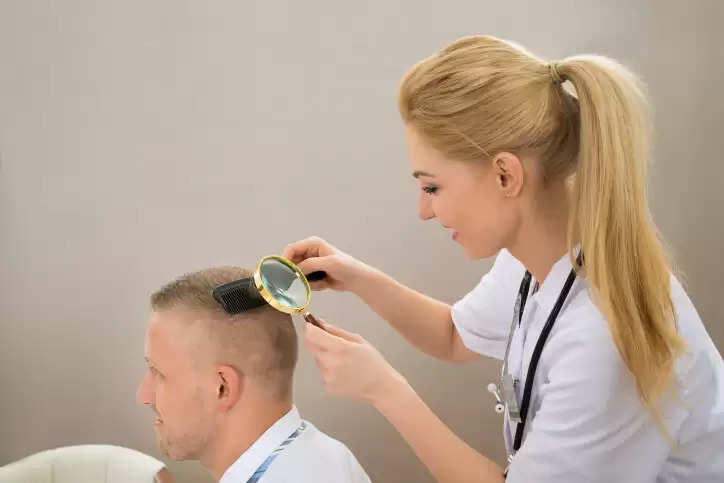‘Vampire Facial’ For Your Scalp
Vampire therapy or Platelet-Rich Plasma (PRP) treatment is popularly being used to treat hair loss leading to baldness or androgenic alopecia. Find out how it works.

Have you been having anxiety and mood swings? Have you noticed a sudden dip in your confidence levels? Do you find yourself battling with negative feelings ranging from lack of interest to social phobia? The reason behind these behavioural changes could be the loss of your crowning glory.
Hair loss and baldness can affect you psychologically more than it affects you physically. Hair thinning and partial/complete baldness (androgenic alopecia) can occur in both men and women but its more common among males and is also called male pattern baldness. Vampire or Platelet-Rich Plasma (PRP) treatment has shown promising results in helping people suffering from hair loss and baldness. So, if you find yourself staring at a receding hairline in the mirror every day, you should definitely know more about it.
Hair today, gone tomorrow
Androgenic alopecia or male pattern baldness loss of hair in a defined pattern such as an M-shaped receding of the hairline. It also results in thinning of hair and men might experience partial or complete baldness. In women, although there is thinning of hair, there is rarely total baldness and neither does the hairline recede.
Such hair loss and hair thinning result from the body’s immune system attacking the hair follicle. While environmental factors also weigh in, it is largely due to increased hormone androgen levels. Androgens are responsible for the shorter life cycle of the hair follicle as well as shorter and thinner hair strands. Scientists have also identified the role of genes in aggravating this condition.
Topical applications such as oils and serums and in-clinic treatments like laser therapy show results that vary from person to person. However, PRP treatment is gaining popularity as a cost-effective and feasible way to treat hair loss and hair thinning a.k.a. androgenic alopecia.
Vampires to the rescue
PRP is popularly called vampire treatment as it involves drawing out blood and reinjecting the platelets back into your bloodstream. However, it is not all fantasy and thrill, there is a medical protocol to be followed as well. Let’s get behind the science of PRP.
PRP therapy is a three-step process and requires three treatments, which are to be performed over a span of four to six weeks. Your doctor might recommend maintenance treatments every four to six months.
It has been successfully used to treat signs of ageing on a face, injured tendons, muscles and ligaments. More research is yet to be done to understand its effect on hair growth but it is a popular option nowadays as some dermatologists and trichologists believe that PRP injections trigger hair growth and help improve the hair’s thickness. When combined with other oral medications and in-clinic hair loss treatments, PRP can prove to be an effective remedy for androgenic alopecia.
How does PRP work?
Step 1: The doctor will draw out your blood and put it in a centrifuge machine. This machine will rapidly spin the blood sample, resulting in different fluids within the blood getting separated based on their density.
Step 2: The blood will give three separate fluids – platelet-poor plasma, platelet-rich plasma and red blood cells. This process will require around 10 minutes.
Step 3: Your doctor will take the platelet-rich plasma in a syringe and inject it into the areas of your scalp that need a boost in hair growth.
Commonly, multiple small injections are given to the scalp in a linear pattern, which is 1 cm apart. The thickness of the epidermis and the number of hair follicles is known to increase after the platelet-rich plasma is injected. Based on the gravity and extent of your hair loss or baldness, your doctor will decide upon the number of treatments and follow-up sessions.
Know the side-effects
You are in no danger of communicable diseases since it is your own platelet-rich plasma that is injected back into your body. However, there are a few other risks involved such as injury to blood vessels or nerves, infection, calcification at the injection points and scar tissue. The treatment involves the use of anaesthesia so a detailed consultation with your medical practitioner is a must to understand the contraindications and limitations involved.
Needle or knife?
Is PRP therapy a more feasible option to treat androgenic alopecia? This requires us to look at what are the other viable solutions. Even with a 360o approach to hair loss, which includes treatments, topical application and medication; hair loss can be curbed but not reversed. To get back a head full of healthy hair requires extensive treatments such as hair transplant surgery. Like any other surgery, it comes with its set of risks and is also expensive. That’s why instead of going under the proverbial knife, people are finding PRP needles a better option. But it all comes down to what you prefer as an individual and what your medical practitioner advises you.
Vampire therapy might be the latest trend in treating hair loss but is it really meant for you? Get a consultation with your dermatologist to seek the right advice.
Disclaimer: The above content is for informational purposes only and should not be used as a substitute for the advice of a qualified physician or doctor. The Company does not vouch for or endorse any of the above content, and disclaims any and all warranties, express or implied, relating to the same.
.png)